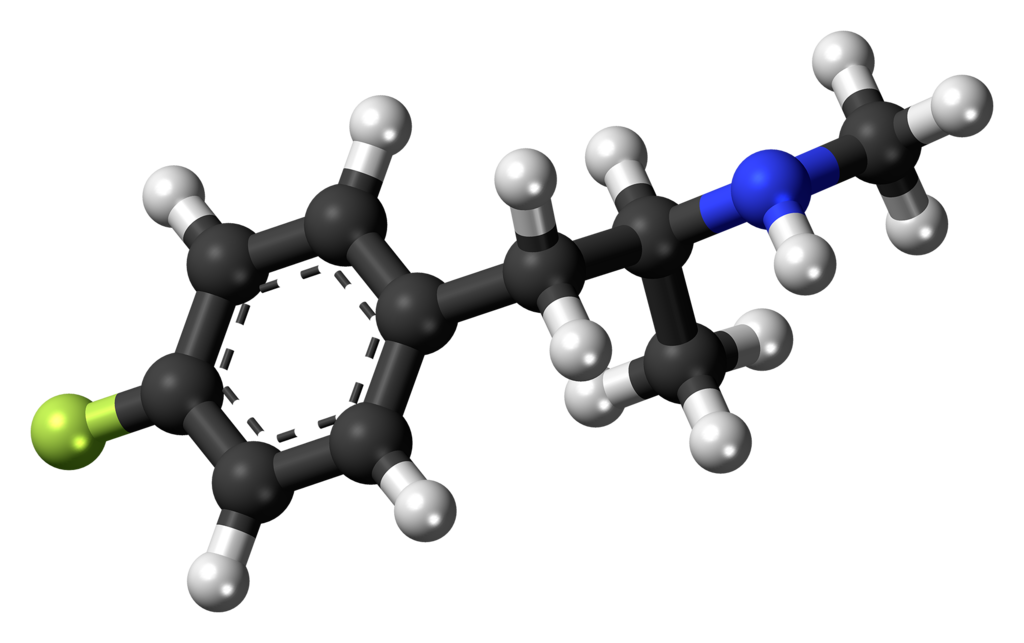Contents
- 1 Summary
- 2 Pharmacology
- 3 Legal status
- 4 FAQ
- 4.1 1. What is 4-Fluoromethamphetamine (4-FMA)?
- 4.2 2. How does 4-FMA affect the body?
- 4.3 3. Is 4-FMA legal?
- 4.4 4. What is the history of 4-FMA?
- 4.5 5. What are the potential risks associated with 4-FMA use?
- 4.6 6. Can 4-FMA be detected in drug tests?
- 4.7 7. Is 4-FMA safe for use?
- 4.8 8. What is the legal status of 4-FMA in various countries?
- 4.9 9. What should I do if I experience adverse effects from 4-FMA use?
- 5 References
Summary
4-Fluoromethamphetamine (4-FMA) is a stimulant substance that shares chemical similarities with both methamphetamine and 4-fluoroamphetamine. Although it has been encountered in the market as a designer drug, it remains relatively mysterious in terms of its pharmacological and toxicological properties.
This compound first came to attention when it was detected in legal highs available in Japan back in 2006. Subsequently, in 2008, Japan imposed legal restrictions on its sale and distribution, making it illegal for these purposes (though personal possession remained permissible).
Initially, reports suggested that 4-FMA was included as an ingredient in certain party pills sold worldwide by the Israeli company Neorganics, starting around 2006. However, further investigation revealed that this information was incorrect, and the actual component was identified as the closely related compound known as 2-fluoromethamphetamine.
| Identifiers | |
|---|---|
| IUPAC name | |
| CAS Number | 351-03-1 52063-62-4 (hydrochloride) |
|---|---|
| PubChem CID | 11745017 |
| ChemSpider | 9919721 |
| UNII | 8LLF59DO7F |
| CompTox Dashboard (EPA) | DTXSID60874103 |
| ECHA InfoCard | 100.254.220 |
| Chemical and physical data | |
| Formula | C10H14FN |
| Molar mass | 167.227 g·mol−1 |

Pharmacology
4-FMA acts as a CYP450 inhibitor, a mechanism through which it influences the metabolism of methamphetamine. This interaction results in heightened potency and duration of methamphetamine’s effects, as well as increased systemic toxicity. Notably, it also serves to diminish the cellular toxicity associated with methamphetamine use.

Legal status
Australia:
In Australia, 4-FMA falls under the classification of a Schedule 9 substance, as per the Poisons Standard (October 2015). A Schedule 9 substance is one with the potential for abuse or misuse, and its manufacture, possession, sale, or use is typically restricted by law. Exceptions are made for medical or scientific research, as well as for analytical, teaching, or training purposes, but only with the approval of Commonwealth and State or Territory Health Authorities.
Canada:
Since 1996, 4-FMA has been categorized as a controlled substance in Canada. This classification stems from its status as an analogue of methamphetamine.
China:
As of October 2015, China has classified 4-FMA as a controlled substance.
United States:
Given its close resemblance to scheduled controlled substances, the sale or possession of 4-FMA in the United States could potentially lead to prosecution under the Federal Analogue Act.
FAQ
1. What is 4-Fluoromethamphetamine (4-FMA)?
- 4-Fluoromethamphetamine (4-FMA) is a synthetic stimulant drug related to methamphetamine and 4-fluoroamphetamine. It is sometimes encountered as a designer drug, but there is limited information available about its properties.
2. How does 4-FMA affect the body?
- The specific effects of 4-FMA on the body are not well-documented due to limited research. It is believed to have stimulant properties, but the extent of its effects, including potential risks, remains unclear.
3. Is 4-FMA legal?
- The legal status of 4-FMA varies by country and jurisdiction. It may be classified as a controlled substance or a prohibited substance in some regions. It is essential to research and understand the legal status of 4-FMA in your specific location before considering its use.
4. What is the history of 4-FMA?
- 4-FMA was first detected in legal highs sold in Japan in 2006. It gained attention as a designer drug but later faced legal restrictions in Japan in 2008. It was initially reported to be an ingredient in certain party pills but was later identified as a related compound called 2-fluoromethamphetamine.
5. What are the potential risks associated with 4-FMA use?
- Due to limited research, the potential risks of 4-FMA use are not well understood. Users should exercise caution and prioritize harm-reduction practices. Adverse effects, long-term consequences, and interactions with other substances remain unclear.
6. Can 4-FMA be detected in drug tests?
- Standard drug tests may not specifically screen for 4-FMA. However, if tested for, it could potentially be detected, depending on the test’s sensitivity and specificity.
7. Is 4-FMA safe for use?
- The safety of 4-FMA has not been thoroughly evaluated, making it a substance of concern. Users should be aware of potential health risks, including unknown long-term effects, and should approach its use with extreme caution.
8. What is the legal status of 4-FMA in various countries?
- The legal status of 4-FMA varies by country. It may be considered a controlled or prohibited substance in some regions, while in others, it may be subject to less stringent regulations. Research the legal status in your specific location before considering its use.
9. What should I do if I experience adverse effects from 4-FMA use?
- If you or someone you know experiences negative effects from 4-FMA use, seek immediate medical attention. It’s crucial to be honest with healthcare professionals about substance use to ensure proper care and support.
References
- The “Consolidated federal laws of Canada, Controlled Drugs and Substances Act” were last updated on March 31, 2022. This legislation governs controlled substances in Canada and can be referenced for legal information regarding substances like 4-Fluoromethamphetamine (4-FMA). (Source: laws-lois.justice.gc.ca, Archived on 2022-06-11, Retrieved 2022-08-11)
- In March 2005, Rösner P, Quednow B, Girreser U, and Junge T published a study titled “Isomeric fluoro-methoxy-phenylalkylamines: a new series of controlled-substance analogues (designer drugs).” This research delved into the emergence of designer drugs related to 4-FMA and similar compounds. (DOI: 10.1016/j.forsciint.2004.05.003, PMID 15639609)
- Nagashima M, Seto T, Takahashi M, Suzuki J, and Yasuda I’s work in 2006, “Spectrum Data of the 3rd Governor-designated Drugs and the Analyses of Uncontrolled Drugs Purchased,” provided insights into controlled substances and their analysis. The study was published in the Tokyo Metropolitan Institute of Public Health Annual Report. (In Japanese, Archived PDF available)
- Camilleri A, Johnston MR, Brennan M, Davis S, and Caldicott DG conducted a chemical analysis in April 2010, examining capsules containing controlled substance analogues, including 4-FMA. Their findings were published in “Forensic Science International.” (DOI: 10.1016/j.forsciint.2009.12.048, PMID 20074881)
- In September 2010, Cherner M, Bousman C, Everall I, Barron D, Letendre S, Vaida F, et al., published “Cytochrome P450-2D6 extensive metabolizers are more vulnerable to methamphetamine-associated neurocognitive impairment: preliminary findings.” This study, featured in the “Journal of the International Neuropsychological Society,” explored the impact of cytochrome P450-2D6 metabolism on individuals using substances like methamphetamine, which has relevance for related compounds such as 4-FMA. (DOI: 10.1017/S1355617710000779, PMC 3543816, PMID 20727252)
- The “Poisons Standard” of the Australian Government, as of October 2015, provides regulatory guidance on substances like 4-FMA within Australia. It outlines the legal status and restrictions surrounding such substances. (Source: Federal Register of Legislation)
- In China, a notice from the China Food and Drug Administration, dated September 27, 2015, introduced the “关于印发《非药用类麻醉药品和精神药品列管办法》的通知” (in Chinese), which addresses the control and regulation of substances including 4-FMA. (Source: China Food and Drug Administration, Archived on 1 October 2015)
- The “Federal Controlled Substance Analogue Act Summary” is a resource found in the Erowid Analog Law Vault. It provides an overview of the U.S. federal legislation regarding controlled substance analogs, which can have implications for substances like 4-FMA.